Commentary on movies past and present by Steve Vertlieb Citizen Kane After the impressive first draft of American had been completed and submitted, Welles began making a number of necessary, if excessive cuts to the script. In subsequent interviews, he inferred to the press that he alone had written what would become Citizen Kane. Mankiewicz became enraged, calling Welles a juvenile delinquent and threatening to go public with his own version of the story. Welles had recently divorced his wife, Virginia, and was happily involved with sultry Dolores Del Rio. He hired perhaps the most inspired cinematographer in Hollywood, Gregg Toland, to photograph his film. Welles knew nothing of the language of film, asking for improvisational set-ups and bizarre shots that had never before been thought of or attempted. He simply cared little that it had never been done before. Toland was excited by the prospect of a more adventurous shoot than was normal in the film community. He indulged his young collaborator, plunging exuberantly into an artistic wonderland, accommodating his every desire and, in so doing, developing an entirely new cinematic dictionary from which motion pictures matured virtually over night. Floors were torn apart, and cameras inserted beneath set level, creating bizarre angles and mesmerizing imagery. Like Howard Hawks before him, Welles experimented with overlapping dialogue and exotic sound effects. Toland's crisp, brooding cinematography created a highly stylized, nearly documentary feel to the picture in which reality disturbingly dissolved into a haunting, netherworld of sullen images and bleak architectural insinuations, evoking a surreal canvas worthy of Gustav Doré. For the music, Welles introduced Bernard Herrmann to a world that would consume the gifted composer for the remainder of his life. Rather than the standard four or five weeks allotted most film composers, Herrmann was allowed a luxurious fourteen weeks in which to construct a score, and was often present on the set conferring with Welles. Herrmann's dramatic instincts were ideally suited to the screen and, like Welles, brought a revolutionary modernism to the newly evolving sound of cinema. Welles allowed only a handful of trusted associates access to the "rushes," among them a young, junior editor who he had taken into his confidence. Robert Wise was a talented technician, infinitely quieter and more introspective than his flamboyant sponsor, but he realized that, despite the spiraling intensity of studio pressure to see what their Merlin was conjuring, he had found an unparalleled opportunity to evolve within this glorious experiment perilous. It wasn't long before Hearst's innumerable spies caught wind of the conspiracy theories unfolding at RKO, inviting catastrophic rage within the vast newspaper empire. The legendary tycoon was mortified at the unhappy prospect of finding ridicule and critical dissection in movie theatres across America. He had no desire to see his world and relationships placed beneath an enormous microscope, and set about instigating harsh, preventative measures. He tried vainly to purchase the negative of the picture from RKO, and have it destroyed. When that failed, he commanded his literary generals to begin a full scale assault on the credibility of the young interloper from New York. The Hollywood branch of his editorial family was lorded over by a rather large, power hungry gossip columnist by the unlikely name of Parsons. The reigning queen of mean, Louella Parsons, began inserting daily doses of artistic poison into her columns, feigning moral outrage she was incapable of realizing...all of which was calculated to prevent release of this threatened outrage filming within the walls of RKO. George Schaefer fought valiantly to preserve the integrity of the director's work, but the economic reality of life in Hollywood would find studio executives cowering in fear at the thought of losing their cherished avenues of promotion. The national community of Hearst newspapers would boycott the studio's releases, refusing to acknowledge or advertise them across the country. They would accept no paid announcements for the release of Citizen Kane, thereby relegating the picture to the trash heap of box office receipts. According to legend, a frantic Welles personally arrived at the New York offices of the studio, dramatically insisting that the very nature of freedom and personal liberty demanded a rejection of Hearst's blatant threat of censorship. Shooting of Citizen Kane began on July 22nd, 1940 and wrapped on October 23rd. Among the visitors to the set were Dada Bernstein and his new bride. After three months of filming, and another seven months of editing, controversy and indecision, Citizen Kane premiered on May 1st, 1941, at the RKO Palace in New York. After Hearst threatened the Rockefeller family with a reciprocal smear campaign should any of their theatres screen the film, Radio City Music Hall politely declined to open it. Predictably, Kane performed reasonably well in the artistic confines of New York but fared far less successfully in middle America where its intellectual pretensions fell upon blank stares and deaf ears. And yet, something unparalleled in motion picture history had occurred...the production and release of a film so daring and revolutionary that it has not only influenced, but dominated the evolution of world cinema for some sixty five years and remains, by common consensus, the single greatest motion picture ever made. The Magnificent Ambersons Welles, despite his bravado, maintained an affectionate melancholy for simpler times and was particularly drawn to Booth Tarkington's nostalgic novel, The Magnificent Ambersons. Since Tarkington had known his father, he even fancied that the character of Eugene Morgan might have been based upon the life of Richard Welles. After disappointing receipts for Citizen Kane, Welles decided that a quieter story of family values might interest middle America more. RKO gave the green light to filming of Ambersons in the summer of 1941 and a new contract was signed on July 7th.
Shooting of the picture began on October 28th. Predictably, the budget exceeded what RKO had expected. While production continued, forces of the Japanese army attacked the American base on Pearl Harbor on December 7th. On the air that night, Welles made an impassioned plea to the American public... "Ladies and Gentlemen, as we all know, our country has answered a vicious and unprovoked attack by declaring war on Japan. This is a time for energetic and unashamed patriotism on the part of all of us. I know we all agree to that because I know that none of us will be satisfied with anything but complete victory." President Roosevelt created the Office of Inter-American Affairs, an agency whose purpose was to foster good will among the Americas. Nelson Rockefeller was asked to take charge of the mission, along with socialite producer, Jock Whitney. Whitney immediately took an interest in the motion picture division of the agency, promoting the good will export of American films to South America in order to further the war effort. He approached Orson Welles about making some personal appearances, and Welles accepted the assignment. He suggested a series of three short films within a film, a documentary of sorts to be called It's All True, based in part upon an earlier failed project with Mexican thematic materials. Meanwhile, filming of Ambersons wrapped on January 22nd, 1942. Welles considered it his masterpiece, a haunting and fragile work of cinematic poetry. He was committed to a February 2nd departure for briefings on the South American venture, joining with Robert Wise in an exhausting three day editing session of The Magnificent Ambersons prior to departure. Welles left for Rio de Janeiro on February 6th, 1942, leaving Wise in control of the nearly completed "cut." Wise would cable Welles in Rio if questions arose, and Welles would wire back his instructions. He trusted Wise and, somewhat precariously, RKO to keep his vision intact while he went to work for the War Department. As raw footage began arriving from Brazil, the studio became increasingly concerned that there seemed no cohesive thread to the material. It seemed confused, without purpose, or any rational semblance of patriotic significance. There was still a good deal of resentment toward Welles in Hollywood where he was perceived as an elitist and a loner. Citizen Kane received nominations for Best Picture, Actor and Director but, when the Academy Award ceremonies were held on February 26th, the Oscar for Best Picture of the year went to John Ford's How Green Was My Valley. Failure of the film to achieve Oscar validation, combined with the rambling quality of rushes from Brazil angered the studio, fostering apprehension and resentment toward their boy wonder. Previews of Ambersons in mid March were not going well and public criticisms ranged from "too talky and boring," to "we don't need trouble pictures." Joseph Cotten attended one of the early screenings, writing that "the feeling in that theatre became disinterested, almost hostile and as cold as that icehouse they had just seen and my heart as heavy as the heart of Major Amberson who was playing wonderful scenes that nobody cared about." George Schaefer tried continually to contact Welles in Brazil in order to voice his concerns over both the fate of The Magnificent Ambersons and the incomprehensible footage he had been receiving for It's All True. Welles, however, was heartily enjoying the local culture and Brazilian women, and could rarely be found by the telephone in his hotel room. Whatever confidence the older producer still had in Welles was rapidly eroding, fearing that the fabled wunderkind was spiraling out of control and restraint. At the command of the studio, and without Welles' intervention or input, Robert Wise was ordered to re-cut Ambersons by forty four minutes, eliminating its delicacy and soul. The negative was confiscated and Welles was barred from interfering in the virtual castration of his masterpiece. Meanwhile, funds were cut off from the well publicized debacle of It's All True and Welles was forced to return to the United States a wounded, severely bloodied artist with a permanently soiled reputation in the industry. It was the end of the beginning, and the beginning of the end for Welles as a director. Like Erich von Stroheim before him, his excesses, lack of focus and vanity seemed to preclude accountability for his behavior, thereby condemning his brief, erratic dominance of the film community to ultimate failure and rejection. What little of the film remains is but a pale shadow of the vision that might have been. Performances, though abbreviated, are uniformly excellent. The musical score by Bernard Herrmann (band leader Ramon Raquello for the celebrated War of the Worlds broadcast four years earlier) once again demonstrated his unique gifts for composition, but the butchered version of the film we've come to know is merely a phantom, a ghost of a would be masterpiece haunting the corridors of our imaginations. Subsequently, the treasured forty four minutes of Ambersons central nervous system were "lost," never to surface again...a mystical plateau in Shangri La...the Holy Grail for film historians and preservationists. Welles and Joseph Cotten had written a screenplay together for Journey Into Fear, based upon the novel by Eric Ambler. Norman Foster directed the picture for RKO, and Cotten took the lead role. The studio, characteristically, was unhappy with Foster's handling of the film and asked Welles to step in at the last minute to re-cut the picture. He did so willingly, if only to be allowed an opportunity to walk back through the doors. The picture, a story of foreign intrigue, was muddled but had the look of a Welles production. Welles, himself, took a minor role in heavy makeup as Colonel Haki, and directed an additional scene with Cotten. Released in 1943, Journey Into Fear had little success at the box office. Norman Foster would go on to direct films and television shows for Walt Disney, most notably the Zorro television series in 1957 on ABC. Jane Eyre - 1944 Twentieth Century Fox had purchased the rights to produce an adaptation of Charlotte Bronte's novel, Jane Eyre, from David O. Selznick and decided to cast Orson Welles as Edward Rochester, opposite Joan Fontaine as Jane. Released in 1943, the picture remains the most memorable of screen interpretations. Directed by Robert Stevenson, and featuring a lush, sultry score by Bernard Herrmann, the picture enticed audiences with the lure of Orson Welles in his single leading romantic role. As the tragic Rochester, Welles delivers a searing portrayal of man robbed of his soul. He is a lonely, empty shell of a man, clinging to tattered particles of honor and nobility. Cast frequently in shadow, his dark, proud eyes and shattering voice proudly concealed a phantom, lost in deep emotional pain. Anguished and alone, his lyrical torment ravished by Herrmann's operatic cloak, Welles is the perfect embodiment of Bronte's tortured hero. Meanwhile, in Hollywood, RKO was taking dramatic steps to repair its image among exhibitors and audiences by publicly divesting itself of anything Wellesian. A new logo began appearing on posters for upcoming releases, and in newspaper and magazine ads promoting their product. It read, simply, "Showmanship Instead of Genius." It was intended to refute the notion that the studio was an effete, intellectual company offering a product too good for the masses, and was an unashamed slap in the face of Orson Welles. Parent had once again abandoned child, while Welles openly referred to himself as "America's youngest has been." Welles had been dating Lena Horne in the early forties, and seemed quite taken by her beauty and maturity. However, it was America's pin-up girl...the girl that every American G.I. wanted to take home to mom...who captured his imagination. Rita Hayworth was, arguably, the most beautiful woman in the movies when Welles was introduced to her. He was taken with her nearly child like vulnerability. Despite her sensual bravado and confidence on screen, Hayworth had been sexually abused by her father and was emotionally fragile. As Rita Cansino, she had danced on stage and in early film appearances with her father. Outwardly, she had become America's Love Goddess. Inwardly, however, she had known little happiness. While Welles was entranced by her beauty and fragility, she was flattered by his wit and brilliance. They married on September 7th, 1943. She assisted him on stage in his magic acts and, on December 17th, 1944, gave birth to their daughter, Rebecca. Welles eventually grew bored with his intellectual superiority to her -- after all, he was intellectually superior to virtually everyone --and by 1945 was seeing Lena Horne once more, and enjoying a torrid affair with Judy Garland. Tomorrow is Forever - 1946 In 1946, Welles took the lead in an independently produced film, Tomorrow is Forever, in which he co-starred with Claudette Colbert and George Brent. Directed by Irving Pichel, Welles played a newlywed during the first world war who leaves his young bride to enlist. Wounded and horribly disfigured, he decides to let his wife believe he has been killed, rather than endure her pity as a scarred, shell of what he had been. Years later he returns to America with a new name and face, and a little girl he cares for as his own child. As emotionally bruised as himself, he adopted the waif after her own parents had been killed in Europe. A chemist now, with a German accent, he finds himself employed by the second husband of his former wife. Sentimental, perhaps. Clichéd, most certainly. Yet, Tomorrow is Forever is a beautiful story and one of the loveliest tearjerkers of the decade. Welles is a haunted specter in a plastic body, only partially convincing a distraught Colbert that he is not her former husband. Max Steiner's rhapsodic score is among his finest, perfectly suiting the romantic tragedy on screen. A young Natalie Wood, meanwhile, is thoroughly disarming as his "daughter." It is compelling melodrama. The Stranger
Edward G. Robinson, in a characteristically wonderful performance, is Wilson, the investigator for the War Crimes Commission, determinedly on his trail. Produced by Sam Spiegel and directed by Welles, himself, The Stranger is a fascinating little film with a marvelous Wellesian set piece at the finale in which he is impaled by the figures of his own beloved clock tower. In 1946, Welles seized upon the idea of directing a big Broadway musical based upon Jules Verne's celebrated novel, Around The World in Eighty Days. Mike Todd would produce the extravaganza, while Cole Porter would compose the tunes. As Welles vision for the show grew, Mike Todd was forced to drop out of the production, claiming that he had been bled financially dry. The show finally opened on Broadway at the Adelphi Theatre on May 31st to mixed reviews. It ran for seventy five performances before closing. Ten years later Mike Todd gained control of the rights to the Verne story once more, producing a highly publicized film version starring David Niven. After Mike Todd had left Around The World in Eighty Days, Welles turned to Harry Cohn, the head of Columbia Pictures for revenue. In return, he would make a picture for Columbia. The project he chose had, unknown to him, already been associated with producer/director, William Castle for the same studio. Welles and Castle collaborated on the project, with Castle writing the first draft of the script and co-producing. Welles would direct the picture and star, along with his estranged wife, Rita Hayworth. For the sake of cohesiveness and believability, Cohn insisted that Welles move back into the house he had shared with his wife.
If I Die Before I Wake by novelist Sherwood King became the basis for one of Welles' most interesting films as a director, The Lady From Shanghai (1948). Welles re-wrote the screenplay for this convoluted thriller of jealousy, deception and revenge, whose most famous sequence entertained a shooting inside a funhouse corridor of mirrors. Reflections expire amidst explosions of shattering shards of glass, clear and lethal daggers assaulting the senses until, one by one, the dastardly pair of conspiring combatants (Everett Sloane and Hayworth) have been killed. Interestingly, both Errol Flynn and his yacht, the Zaca, were employed for the film as boat, and off camera skipper. The marriage was over, and Welles' business and financial affairs were disastrously in disarray. However, he continued to act, direct, write and produce for the theatre, films and radio. In 1948 he directed and starred in an exciting, beautifully realized adaptation of Shakespeare's Macbeth for Republic Pictures. The next year, for producer Edward Small, he delivered a mesmerizing performance as the evil magician, Cagliostro, for the otherwise mediocre Black Magic. During that same year, Welles offered one of his most charismatic performances as Harry Lime in Carol Reed's classic thriller, The Third Man. No stranger to controversy or artistic espionage, he had earlier been considered a communist by the FBI for his persistent liberal writings and speeches. For The Third Man, Welles assumed the identity of an utterly charming swine, proliferating the ugliest drug trafficking in Europe. Believing Lime dead, an old friend (Joseph Cotten) is consumed by moral outrage in learning the trouble with Harry. Discovering the chaotic chameleon still very much alive, under Reed's breathtaking staging, Holly pursues Harry in righteous indignation and with murderous intent...all to the accompaniment of the withering zither score by Anton Karas.
With Herculean effort, he somehow managed to keep his casts together, even though there would be With Herculean effort, he somehow managed to keep his casts together, even though there would be monumental gaps between filming. He would often begin filming, run out of funds, perform for other directors and producers, then re-group and begin where he had left off. Othello took four years to complete, with his cast members remaining steadfast and loyal. For all of his infamous squandering of funds, he remained among a handful of certified geniuses whose gifts would become the stuff of legend. His company of players knew that they had participated in something quite special, and they remained loyal to the master. During this period, Welles made several trips to Dublin where friends and corresponding debts flourished. He appeared in a short, twenty three minute ghost story, directed by Hilton Edwards, titled Return to Glennascaul. Meanwhile, Othello premiered in 1952 in Cannes, winning the prestigious Palme d’Or for his efforts. In England in 1951, Harry Alan Towers produced a series of radio programs based loosely upon the Harry Lime character Welles played in The Third Man. Retaining little beyond the name of the character, Welles once again starred as Lime. For this incarnation, however, Lime was portrayed more as a heroic detective. Welles himself wrote some of the scripts, particularly an episode called "Greek Meets Greek" about a Greek tycoon who hires an investigator to look into his own mysterious past. He began composing a novel from the radio episode, in which the magnate's name was Arkadian. From this idea seemingly sprang Welles' next directorial effort, Mr. Arkadin...an interesting, if murky melodrama released in 1955. Also known as Confidential Report, the picture starred Welles as Gregory Arkadin. During the editing of Mr. Arkadin, John Huston hired Welles for a mere two days work to play Father Mapple in his film version of Moby Dick. Welles was concurrently writing his own theatrical production of Moby Dick to be presented on the British stage. Envisioned as a philosophical exercise in which a company of nineteenth century actors, preparing their presentation of King Lear, digress to rehearse Moby Dick, the play featured Welles as Ahab and Patrick McGoohan as the idealistic Starbuck. Since it was conceived as a "rehearsal," the venture precluded the need for sets. The play enjoyed an all-too-brief run at the Duke of York's Theatre until, predictably, funds ran out. Welles wanted to find a way to film the production, sobbing in frustration when it became apparent that it would never be. Touch of Evil 1957 In 1957, Universal hired Charlton Heston to star in their screen version of Badge of Evil, based upon a novel by Whit Masterson. Paul Monash had written a script for the picture, now titled Touch of Evil, about a corrupt sheriff in a small Mexican town. Orson Welles had been chosen to play the heavy, but a director had not yet been assigned to the project.
Heston lobbied heavily for Welles, and his selection suddenly seemed to everyone within the studio hierarchy an inspired choice. Welles brought in his makeup man from Citizen Kane, Maurice Seiderman, to create the sleazy, slovenly appearance of the decaying, bigoted sheriff. The film is filled with wonderful performances by some of the finest character actors and actresses in Hollywood, including Akim Tamiroff, Joseph Calleia and Dennis Weaver. As for the leading roles, Janet Leigh clearly delivers a powerful, nerve wracking portrayal as the drugged and kidnapped wife of Heston's Mexican district attorney, while Welles is, himself, impossible to take your eyes off of. Marlene Dietrich is often fascinating in a role that conjures memories of her Gypsy alter ego in Golden Earings ten years earlier. However, the most mesmerizing performance in Touch of Evil is the director's astonishing contribution as a filmmaker extraordinaire. This is the old Welles returning to the scene of his prime, a brilliant creative artist enjoying consummate reverence for his craft. His legendary opening tracking shot, the chilling...nearly nightmarish hint of rape, dark corners and crevasses within a pretense of mannered or lawful society, the shadowy underbelly of corruption, unforgettably painting a seedy canvas of danger and uneasy tension...this is a final masterpiece from one of the screen's handful of genuine visionaries. Yet, fate would once again have the last laugh, robbing Welles of the critical acclaim he was due. As Universal grew more conservative in its handling of the picture, Welles grew more defensive and ultimately abusive, defiantly refusing to honor studio requests for clarity or brevity. Ultimately, upon its release in 1958, Universal had taken a cue from RKO, re-cutting the picture without input from the director, shortening its length by some fifteen minutes and assigning a studio director, Harry Keller, to shoot some additional scenes. Orson Welles had allowed himself to be castrated once again by a marauding band of company jackals. Eventually, Touch of Evil was restored to its director's "cut" but far too late for Welles to enjoy the blossoming fruit of his artistic labors.
Orson Welles in Compulsion
The Trial (1962) is an often brilliant, visual exploration of Franz Kafka's frightening novel, while Chimes At Midnight (1966), filmed on locations in Spain, was a heroic homage to Shakespeare's Falstaff. In 1980 he directed a controversial exploration of a flamboyant film director, patterned after himself and enacted by another difficult director, John Huston. Tantalizing as the completed sequences appear, The Other Side of the Wind was left unfinished, never entirely realized.
Endless years of excess and lack of rational accountability had finally done him in. The man who could do anything had, at least in his own mind, done nothing. He had dwelt in a mythical castle, a skeletal sarcophagus erected to epic proportions with grand tales that conquered reason and responsibility. The Xanadu of Charles Foster Kane became a repository for a lifetime of failed dreams...a lonely sled left out in the snow to wither and expire. Then, during the early morning hours of October 10th, 1985...as it must to all men...death came to George Orson Welles.
|
Other unexplained photos on this site:
If you have a suggestion or a photo to submit, send it to:
Editor/viewzone.com
myristicin@hotmail.com
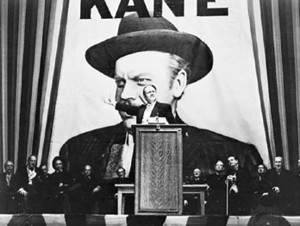 Welles would direct, write and produce the picture but not perform in it. The lead role was given to Joseph Cotten. Welles wrote a deeply sensitive and literate screenplay about the passage of time and values, adding a poignant finale of his own, not found in the original novel. The story was a tragic tale of changing cultures, and of a social climate gone with the wind. It would not pander to the tastes of simplistic audiences but, rather, pose provocative questions uneasily resolved.
Welles would direct, write and produce the picture but not perform in it. The lead role was given to Joseph Cotten. Welles wrote a deeply sensitive and literate screenplay about the passage of time and values, adding a poignant finale of his own, not found in the original novel. The story was a tragic tale of changing cultures, and of a social climate gone with the wind. It would not pander to the tastes of simplistic audiences but, rather, pose provocative questions uneasily resolved.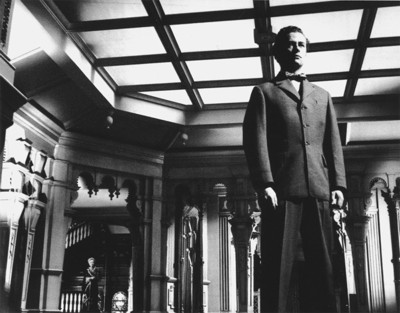 For his next film, Welles played another German character, but this time for real. In The Stranger, he is an escaped Nazi war criminal, hiding out in a small college community in America as a thoughtful professor. He marries the daughter of a Supreme Court Justice, Loretta Young, for security and has a fascination with clocks. Posing as Charles Rankin, he is actually Franz Kindler, among the most notorious Nazi butchers of the war.
For his next film, Welles played another German character, but this time for real. In The Stranger, he is an escaped Nazi war criminal, hiding out in a small college community in America as a thoughtful professor. He marries the daughter of a Supreme Court Justice, Loretta Young, for security and has a fascination with clocks. Posing as Charles Rankin, he is actually Franz Kindler, among the most notorious Nazi butchers of the war.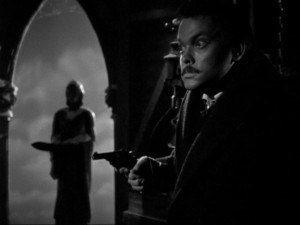 Orson Welles as Macbeth [right].
Orson Welles as Macbeth [right]. 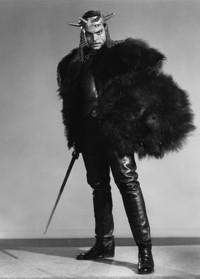 Welles frequently worked as an actor in order to help finance his own productions. With funds from The Third Man in 1948, he began work on his film version of Othello. Major studios had grown understandably wary of his excesses and so he spent much of the remainder of his life funding his own pictures with whatever finances he could beg, borrow or quite literally steal.
Welles frequently worked as an actor in order to help finance his own productions. With funds from The Third Man in 1948, he began work on his film version of Othello. Major studios had grown understandably wary of his excesses and so he spent much of the remainder of his life funding his own pictures with whatever finances he could beg, borrow or quite literally steal. 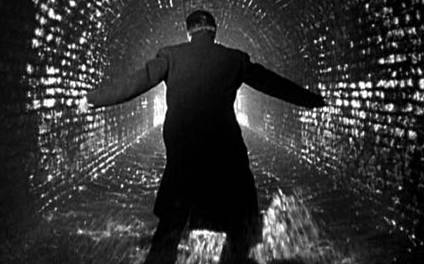 Heston, who was riding high on a wave of success and popularity, remarked to studio executives "You know, Orson Welles is a pretty good director." It certainly didn't hurt that William Alland, now a producer for Universal, had worked with Welles on Citizen Kane, and for the Mercury Theatre radio company.
Heston, who was riding high on a wave of success and popularity, remarked to studio executives "You know, Orson Welles is a pretty good director." It certainly didn't hurt that William Alland, now a producer for Universal, had worked with Welles on Citizen Kane, and for the Mercury Theatre radio company.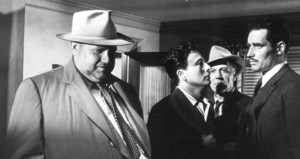 Such would be the frustrating pattern of his remaining years. His size ballooned until he had become a twisted parody of the "beautiful boy" who had so enchanted his elders and peers. His consumption of food, alcohol and women exploded beyond rational expectation, while his legendary temper required little to detonate. The consensual degradation of this incomparable cinematic magician became heart breaking to witness. Succumbing to the most unashamedly blatant prostitution of his persona, he began selling his image and name to virtually anyone who would pay for it...anything to raise more funds for partially realized or abandoned film projects in the fragile years to come. He even succumbed to the shameless burlesque buffoonery of Lucille Ball in a classic 1956 episode of television's I Love Lucy.
Such would be the frustrating pattern of his remaining years. His size ballooned until he had become a twisted parody of the "beautiful boy" who had so enchanted his elders and peers. His consumption of food, alcohol and women exploded beyond rational expectation, while his legendary temper required little to detonate. The consensual degradation of this incomparable cinematic magician became heart breaking to witness. Succumbing to the most unashamedly blatant prostitution of his persona, he began selling his image and name to virtually anyone who would pay for it...anything to raise more funds for partially realized or abandoned film projects in the fragile years to come. He even succumbed to the shameless burlesque buffoonery of Lucille Ball in a classic 1956 episode of television's I Love Lucy. 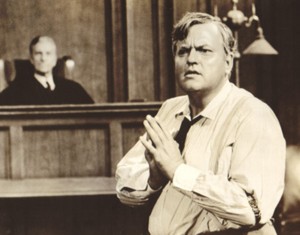 Yet, there were moments of triumphant artistry involving other areas of his creative mastery of the arts. His narrative skills were ever in demand and, in 1961, he signed to perform the moving narration for Samuel Bronston's remake of Cecil B. DeMille's King of Kings. His voice was, perhaps, the most wondrously beautiful instrument in the history of film. Here he was, in all his stunning vocal majesty, speaking the spiritual text written by Ray Bradbury, to the magnificent musical accompaniment of the incomparable Miklos Rozsa. His powerfully commanding voice could still the night, bringing warmth and comforting reassurance to the Winter's chill. Miraculously, he managed to finish a mere handful of remaining pictures as a director.
Yet, there were moments of triumphant artistry involving other areas of his creative mastery of the arts. His narrative skills were ever in demand and, in 1961, he signed to perform the moving narration for Samuel Bronston's remake of Cecil B. DeMille's King of Kings. His voice was, perhaps, the most wondrously beautiful instrument in the history of film. Here he was, in all his stunning vocal majesty, speaking the spiritual text written by Ray Bradbury, to the magnificent musical accompaniment of the incomparable Miklos Rozsa. His powerfully commanding voice could still the night, bringing warmth and comforting reassurance to the Winter's chill. Miraculously, he managed to finish a mere handful of remaining pictures as a director.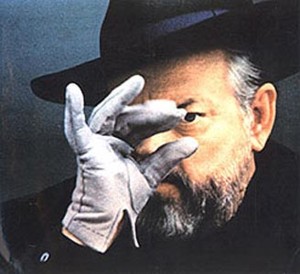 The American Film Institute presented Welles, perhaps too late, in February, 1975 with its prestigious trophy and televised celebration honoring a life in film. Presided over by host, Frank Sinatra, the program shared a whisper of melancholy reflection. Still, as he tearfully lamented in a hotel room to Peter Bogdanovich years later, it was truly over. He had battled his personal demons, and lost.
The American Film Institute presented Welles, perhaps too late, in February, 1975 with its prestigious trophy and televised celebration honoring a life in film. Presided over by host, Frank Sinatra, the program shared a whisper of melancholy reflection. Still, as he tearfully lamented in a hotel room to Peter Bogdanovich years later, it was truly over. He had battled his personal demons, and lost.